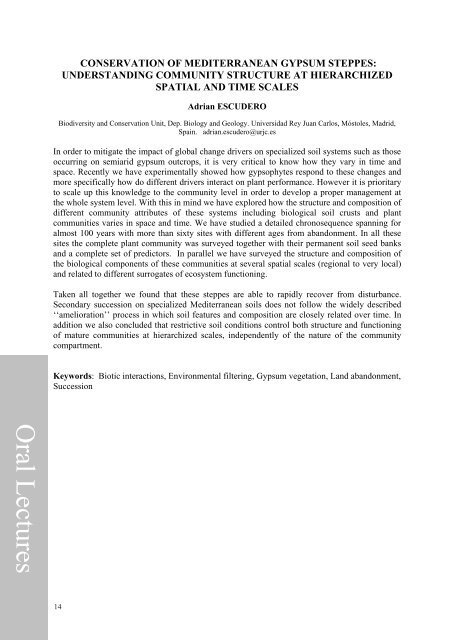Adil GÜNER, Vehbi ESER - optima
Adil GÜNER, Vehbi ESER - optima
Adil GÜNER, Vehbi ESER - optima
You also want an ePaper? Increase the reach of your titles
YUMPU automatically turns print PDFs into web optimized ePapers that Google loves.
Oral Lectures<br />
14<br />
CONSERVATION OF MEDITERRANEAN GYPSUM STEPPES:<br />
UNDERSTANDING COMMUNITY STRUCTURE AT HIERARCHIZED<br />
SPATIAL AND TIME SCALES<br />
Adrian ESCUDERO<br />
Biodiversity and Conservation Unit, Dep. Biology and Geology. Universidad Rey Juan Carlos, Móstoles, Madrid,<br />
Spain. adrian.escudero@urjc.es<br />
In order to mitigate the impact of global change drivers on specialized soil systems such as those<br />
occurring on semiarid gypsum outcrops, it is very critical to know how they vary in time and<br />
space. Recently we have experimentally showed how gypsophytes respond to these changes and<br />
more specifically how do different drivers interact on plant performance. However it is prioritary<br />
to scale up this knowledge to the community level in order to develop a proper management at<br />
the whole system level. With this in mind we have explored how the structure and composition of<br />
different community attributes of these systems including biological soil crusts and plant<br />
communities varies in space and time. We have studied a detailed chronosequence spanning for<br />
almost 100 years with more than sixty sites with different ages from abandonment. In all these<br />
sites the complete plant community was surveyed together with their permanent soil seed banks<br />
and a complete set of predictors. In parallel we have surveyed the structure and composition of<br />
the biological components of these communities at several spatial scales (regional to very local)<br />
and related to different surrogates of ecosystem functioning.<br />
Taken all together we found that these steppes are able to rapidly recover from disturbance.<br />
Secondary succession on specialized Mediterranean soils does not follow the widely described<br />
‘‘amelioration’’ process in which soil features and composition are closely related over time. In<br />
addition we also concluded that restrictive soil conditions control both structure and functioning<br />
of mature communities at hierarchized scales, independently of the nature of the community<br />
compartment.<br />
Keywords: Biotic interactions, Environmental filtering, Gypsum vegetation, Land abandonment,<br />
Succession<br />
2






